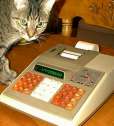dip POCKET pc
| Datasheet legend
Ab/c:
Fractions calculation
AC: Alternating current BaseN: Number base calculations Card: Magnetic card storage Cmem: Continuous memory Cond: Conditional execution Const: Scientific constants Cplx: Complex number arithmetic DC: Direct current Eqlib: Equation library Exp: Exponential/log functions Fin: Financial functions Grph: Graphing capability Hyp: Hyperbolic functions Ind: Indirect addressing Intg: Numerical integration Jump: Unconditional jump (GOTO) Lbl: Program labels LCD: Liquid Crystal Display LED: Light-Emitting Diode Li-ion: Li-ion rechargeable battery Lreg: Linear regression (2-var. stats) mA: Milliamperes of current Mtrx: Matrix support NiCd: Nickel-Cadmium recharg. batt. NiMH: Nickel-metal-hydrite rech. batt. Prnt: Printer RTC: Real-time clock Sdev: Standard deviation (1-var. stats) Solv: Equation solver Subr: Subroutine call capability Symb: Symbolic computing Tape: Magnetic tape storage Trig: Trigonometric functions Units: Unit conversions VAC: Volts AC VDC: Volts DC |
| ||||||||||||||||||||||||||||||||||||||||||||||||||||||||
dip POCKET pc
 On another page, I described the Atari Portfolio as the world's first pocket-size IBM compatible computer. In a sense, this is true; but Atari was not the company that developed this machine. That proud claim goes to a little-known British company, Distributed Information Processing of Guildford, UK, whose POCKET pc became the Portfolio after Atari purchased the product from them.
On another page, I described the Atari Portfolio as the world's first pocket-size IBM compatible computer. In a sense, this is true; but Atari was not the company that developed this machine. That proud claim goes to a little-known British company, Distributed Information Processing of Guildford, UK, whose POCKET pc became the Portfolio after Atari purchased the product from them.
I do not know if the machine was ever sold in stores under the dip brand name. I have my doubts; after all, even though it carries the dip label, the machine's keyboard already features an Atari logo key. Then again, the machine has a genuine serial number, and the appearance of a finished product, so...
My fondness for this little machine has not diminished. Although the built-in applications are a little Spartan, and the internal memory is a meager 128 kilobytes, it already foreshadowed the era of the handheld or pocket "companion PC" that has enough features to let you perform simple tasks on the road, and transfer the results to your desktop computer later.
My biggest lament is that like its distant Windows CE cousins, the POCKET pc is not really programmable. Oh, you can write plenty of applications for it using external tools (like your 16-bit C compiler on your desktop PC) but there are no built-in programming tools. No BASIC interpreter. Not even a lousy copy of that standard MS-DOS tool, DEBUG.COM.
Except... well, the built-in spreadsheet application does offer some "programmability" after all. Because it has a conditional function (@IF) and a loop sum function (@SUM), complex algorithms can be implemented using a properly consturcted spreadsheet.
To demonstrate this, I decided to try and implement Gamma function using the POCKET pc's spreadsheet application. More specifically, I am using the Lanczos approximation to compute the natural logarithm of the Gamma function to an accuracy of approx. 12 digits. A conditional expression allows me to compute the Gamma function for negative values:
| A | B | C | D | |
| 1 |
arg |
@IF(A1>0,C1,@LN(@PI/D1/@SIN(@PI*A1))-C1) | +D3+(D1-0.5)*@LN(D4)-D4 | @ABS(A1) |
| 2 | 1 | 2.5066282756348 | +A2*B2 | 5.15 |
| 3 | 1/D1 | 225.52558461918 | +A3*B3 | @LN(@SUM(C2..C7)) |
| 4 | 1/(D1+1) | -268.2959738413 | +A4*B4 | +D1+D2-0.5 |
| 5 | 1/(D1+2) | 80.903080693462 | +A5*B5 | |
| 6 | 1/(D1+3) | -5.0075786397052 | +A6*B6 | @EXP(B1) |
| 7 | 1/(D1+4) | 0.01146848954348 | +A7*B7 |


